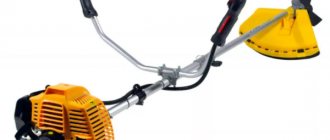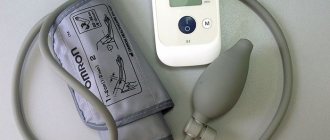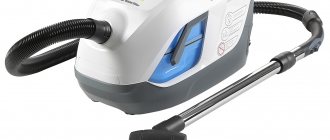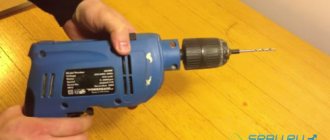Types of screwdrivers
Electric screwdrivers
Highly specialized devices that are designed exclusively for tightening self-tapping screws, screws or other fasteners using the appropriate attachments included with the device. The gadget is designed to facilitate the process of assembling furniture, maintaining any equipment and finds its application in almost all areas of human life.
Since cordless screwdrivers are limited in their functionality, manufacturers strive to maximize the usability of these devices by increasing battery life, equipping the working head of the device with a rotating mechanism and increasing the number of revolutions of the torque shaft.
Electric impact wrenches
These devices are a full-fledged mechanized replacement for wrenches and are aimed at tightening and loosening bolted joints of various diameters, and have high power and shaft torque. This is explained by the fact that fasteners of this type are used in more complex mechanisms, where a “tight” fit is required, simultaneously ensuring:
- relatively good tightness of the connection;
- the strength of the connection itself (obviously, the degree of tightness of a screw in a laptop and a car wheel bolt will vary greatly, as will the consequences of under-tightening);
- good screw-in quality, that is, with the proper operating torque, the thread should in no case be torn off.
Drills and screwdrivers
The most diverse group of electric drills, the devices of which differ from those listed above in that they can be equipped with drills and, accordingly, be used as a full-fledged drill for drilling holes. Advanced models are capable of not only determining the depth of the drill into the wall using an artificial limiter in the drilling mode, but also automatically feeding screws in the tightening mode.
The undeniable advantages of such a gadget are its versatility, flexibility (the device can be used with drills and screws of various diameters) and the ability to fine-tune it, namely, changing the speed of rotation of the shaft, which is very important when tightening thin screws.
However, it is worth considering that a drill-driver is needed in exceptional cases (repair, major or primary), since it is still a professional tool, therefore it is more practical to choose a drill-driver for the home from cheaper and more practical analogues.
HOW TO CHOOSE THE CORRECT PARAMETERS OF A DRILL-SCREWDRIVERS? + (VIDEO)
The cost and quality of a product consists of several components. You can find out about them in the product instructions. Be sure to learn about these parameters:
- motor power;
- purpose of the tool;
- number of revolutions and torque;
- information about batteries (if you like this type);
- how to change the tip (is it possible to quickly change it);
- some additional functions (for example, a flashlight for working in poor visibility conditions);
- manufacturer.
Now let's look at each point in detail.
Rule No. 1 when choosing a drill of any type is to pay attention to power. For household copies it is significantly less than for professional ones. For minor repairs, 0.6 kW is usually enough; for everything else, it is advisable to choose a power from 0.9 kW.
Another important detail is the torque indicator. The higher it is, the greater the power. High torque means the tool can handle heavy-duty drilling or screwdriving.
Ease of operation and its quality will be ensured by such a parameter as the number of revolutions. If the tool is used as a screwdriver, then 500 rpm is sufficient. When drilling, you will need from 1200 revolutions. A good product should have the ability to set the required number of revolutions.
Main characteristics and criteria for choosing a device
Battery and mains models
As everyone probably knows, screwdrivers can receive electricity in two ways, directly from a 220 V network or from a power source (there are two types of batteries on the market now, lithium-ion and nickel-cadmium) . Comparing devices that are different in this regard, it should be said that:
- Network gadgets will always weigh 500-600 grams less than their portable counterparts;
- Cordless screwdrivers, which are in the same price segment as corded ones, have an order of magnitude lower maximum and operating power;
- Network devices can be equipped with a small safety battery, which is needed to prevent the gadget from breaking down in the event of network surges.
The choice of cordless screwdriver comes from models of a universal type or a more specialized one. As numerous comparative analyzes show, at the same cost, the most technically equipped devices are inferior in terms of autonomy to gadgets with a strictly defined purpose.
Battery type
Although it was mentioned above that there are two types of batteries on the market, lithium-ion batteries are gradually completely replacing nickel-cadmium batteries, being their best and most advanced analogue. Firstly, such batteries have a higher charge distribution density, which means that 1 cm3 of such a battery will have greater energy capacity than 1 cm3 of a nickel-based battery.
Secondly, all types of nickel batteries (nickel-cadmium and nickel-metal hydride) have a significant drawback in the form of a “memory effect”, which consists in the fact that when frequently charging a battery that is not completely discharged, crystalline formations of the active substance begin to enlarge in places , where it was not used (since the user started forced charging). Over time, the area of the substance increases and it becomes impossible to use it. As a result, the battery loses its capacity and battery life is seriously reduced. Lithium-ion based batteries do not have such disadvantages; they can be charged as many times as you like without worrying about the correct mode.
Chuck type
In various types of screwdrivers, a chuck is a clamping device into which a particular attachment or drill is inserted; in this case, the central axis of the chuck must be compared with the central axis of the spindle (shaft), through which rotation will be transmitted. Currently, there are three main varieties:
- A key chuck, which finds its use in drills and hard-type screwdrivers, since it grips drills and bits with several legs (or “cams”) located equidistant from each other. Usually three legs are used, the angle between each pair is 120°. Fixation is carried out only with the help of a special key; it is not possible to remove the nozzle without it. It is this type of chuck that is recommended to be used when working with materials of high hardness, in which the screwdriver is subject to constant high impact loads;
- The chuck is of a quick-release type, the fastening of the nozzle to which is based on its ordinary tightening using an adjusting sleeve. The sleeve consists of two couplings, upper and lower, both made in the vast majority of cases from plastic;
- A bit chuck designed exclusively for connecting the screwdriver shaft with a bit, an attachment, the shape of which can vary from standard (hexagonal) to arbitrary (star or cruciform).
To be honest, when buying a screwdriver, you don’t have to think about which cartridge to choose for it, since manufacturers usually write the relevant data in the device’s passport: what parts it can be used with, what components can be purchased as additional ones, and why one or another is recommended cartridge type.
Brush/brushless motor
Without going into technical details, the main difference between brushed and brushless screwdriver motors is the principle of switching current within the device, which is necessary to control the device, activate it and configure it. Brushless motors are more advanced and modern, since the function of reading current readings is assigned to the electronic component of the device. Devices with such engines are more durable due to the smaller number of rubbing elements, have a high efficiency index, and in most cases have many times more speeds than their classic counterparts, but at the same time their cost and maintenance are noticeably higher.
Brush motors of screwdrivers are equipped with a commutator-brush assembly, which is responsible for transmitting current to the motor armature; Brushes are usually made of carbon and graphite. The devices are relatively simple in technical terms, easy to repair, but at the same time they require service more often and are functionally limited due to the small number of options for adjusting the current.
Reading the advice of experienced builders and craftsmen, you can immediately come to the conclusion that the brushless option is much better and you should purchase a model of this type without any alternative, but this would be the wrong decision. If the screwdriver is not used as often, for example, for rare assembly of furniture at home or solving other household tasks, a brush screwdriver will last as long as its more modern “brother”.
Power
Obviously, as the power of a screwdriver’s engine increases, so does the complexity of fastening the connection, which the device can handle. At the same time, it is also worth focusing on the type of device: at the same cost, universal models will always have a power that is several tens of W less than those designed to solve specific problems.
It is believed that tools whose maximum power value does not exceed 500 W are quite suitable for solving everyday problems: such a device can quite confidently cope with unscrewing the wheel bolts of a regular car, drill a hole in both a panel and a brick wall, and even tighten bolts on large flanges. To solve construction problems (for example, assembling fundamental metal structures), you will need a device whose operating power exceeds 1 kW.
Torque
A characteristic that various companies like to boast about, overestimating its indicator and giving a very vague idea of how productive a particular device being sold is. Thus, a moment of 1 N * m is an indicator of force that is equivalent to the force created by a body whose mass is 1 kg and which is attached to a force-generating lever 1 m long.
Even the interpretation of torque can mislead inexperienced users, let alone the high values of this characteristic. Needless to say, when working with different materials (for example, hard wood or light plasterboard), the device will behave completely differently, and the applied effort from the person (load) will have a much greater impact on the drilling process. To solve everyday problems, a torque value of 15-25 N*m is quite enough; this is enough even for drilling standard holes in the wall for a dowel. It is clear that professional models, the torque of which can even exceed 80-100 N*m, will tighten screws more quickly and easily fit into any type of wall, but it makes no sense to purchase such devices for far from everyday use.
Drill/nozzle rotation speed and number of speeds
What you need to pay attention to is the drill rotation speed parameter, which is decisive in the work in combination with the power of the tool. It is believed that to screw standard self-tapping screws into tile, brick and concrete walls, it is enough for the spindle to spin the nozzle up to 500 rpm; higher values are required for professional devices for which speed is important when screwing a large number of fasteners.
For drilling, it is recommended to stop at a rotation speed of 1,500 rpm, the minimum threshold is 1,300. Accordingly, when purchasing a universal drill-driver, the speed parameter should be at least 1,300 rpm.
First-class devices are able to work with different numbers of revolutions per minute and allow the user to independently select the rotation speed by turning the corresponding slider on the screwdriver body. The number of speeds in middle-class models is usually 12-16, and this is a good indicator.
Operating modes
The number of operating modes determines whether the device is universal or not, how predisposed it is to a particular type of operation, and how exactly it is recommended to use it. So, they distinguish:
- Classic drilling mode, which implies standard rotation of the shaft around its longitudinal axis;
- Impact mode of operation, which differs from the one described above in that during the drilling process, a reciprocating movement is also carried out simultaneously with the drill with normal rotation. That is, without user intervention, the drill both hits the surface being drilled and goes deeper towards it. Non-impact models usually include screwdrivers and impact wrenches and some budget drills that are designed to work with weak materials;
- In the chiselling mode, only a reciprocating movement is carried out; the drill or attachment strikes a predetermined location;
- Reverse operating mode, causing the shaft to rotate in the opposite standard direction, that is, counterclockwise;
- Pulse mode that activates the motor shaft at certain intervals, which makes it easier to unscrew screws stuck with rust.
Shape and size
It’s no secret that choosing the shape of a screwdriver is an individual matter, since the shape of the hand, its size and the distance between people’s fingers can vary greatly, and in this regard, the devices on the market are especially different from large companies that are able to release gadgets of different sizes to the market, but included in one line.
It should be noted that the size, coupled with weight, also depends on whether the device is battery-powered or not, since portable models with a high battery life will always be significantly heavier and larger than their networked counterparts. The size and power rating of the engine also influences in the same way: the higher it is, the larger the device will be.
If the screwdriver is intended for unscrewing small-diameter screws (for example, for disassembling/assembling household appliances), then its size will be able to fit into a pocket.
Equipment
The cost of purchasing a particular screwdriver directly depends on what else comes with it. A good package should include at least two elements from the list below:
- replaceable battery if the device is portable;
- cross-shaped nozzles of different sizes;
- nozzles for nuts with a diameter of 5 to 15 mm;
- drills for materials of various hardness (brick, concrete, wood);
- restrictive nozzles and drills;
- plastic case for storing and transporting the screwdriver.
Additional functions
Additional functions and systems include certain features of the device that make it easier and simpler to work with a screwdriver, allowing, for example, to easily use the device in hard-to-reach fastening areas due to the 180° rotatable head. Other similar systems include:
- Anti-vibration mechanism, which helps to significantly reduce vibrations transmitted along the handle from the drill;
- System for using nozzles without a cartridge. Some screwdrivers have the ability to attach attachments without an intermediary shaft, which reduces the unused length of the handle and allows the operator to easily unscrew or tighten a screw in a previously inaccessible place;
- The ability to use the device as a mixer of paints, cement mixtures, clay solutions and other fluid materials;
- The presence of electronic overload protection during operation allows the device to automatically turn off the engine to prevent combustion of it or its components.
Battery characteristics for cordless screwdrivers
The power of a cordless tool, as well as the duration of its operation, are determined by the characteristics of the battery.
Battery types
Ni-Cd – nickel-cadmium batteries. Their characteristic difference from other types of batteries is that such batteries can be used at low temperatures (from 0°C and below). Also, batteries have a fairly long service life, subject to proper operation, low cost and up to 1000 effective charge cycles.
The disadvantages of nickel-cadmium batteries include their rapid self-discharge and mandatory complete discharge before connecting to a charger. This requirement is explained by the presence of a memory effect in the battery, which subsequently reduces the battery capacity.
Ni-MH – nickel-metal hydride batteries. They have a higher capacity, compared to Ni-Cd batteries, and a greater number of charge-discharge cycles (up to 1500). The disadvantages of these batteries are as follows:
- high price;
- fast discharge at high loads;
- impossibility of use at subzero temperatures.
Li-ion – lithium-ion batteries. They have a large capacity and retain it for a long time, and charge quickly. But lithium-ion batteries are not designed to operate at low temperatures and quickly lose their charge. In addition, lithium-ion batteries cannot be completely discharged. As a result, the battery capacity decreases, and after several complete discharge cycles it fails.
When purchasing a tool with a lithium battery, be sure to check the production date of the battery. Unlike other types, Li-ion batteries have a limited shelf life.
Capacity
The time during which the tool will work effectively depends on this parameter. The higher the battery capacity, the longer the device will work without recharging. But do not forget that no matter what battery you choose, its capacity will gradually decrease over time.
Voltage
This battery parameter directly affects the torque and can be in the range from 9 to 36 V. The lower the voltage, the lower the torque. For example, if the battery voltage is 9 volts, then this will not be enough for drilling and installing wooden structures, tightening long screws, etc. For such work, a device with a battery with a voltage of 12-14 V is suitable.
Choosing between professional and household tools
As has been repeated many times above, before purchasing, it is very important to determine the scope of application of the device; it depends on what parameters you need to look at when buying a screwdriver in the first place, and which will be secondary.
It is obvious that the household appliance will be used for its intended purpose only sporadically, it will not have a long battery life, and will most likely be supplied with a standard set of cross-head sockets and a pair of 9 and 11 mm nuts. Such screwdrivers will be suitable for quickly assembling, for example, a chair or a folding sofa, but in no case will they be suitable for drilling in metal, since they simply do not have enough power and shaft rotation speed.
A professional tool will be equipped with the latest technology, have several operating modes along with additional ones (for example, the same mixer that no one would need at home), be equipped with a huge number of attachments and drills, and will most likely have a brushless motor. All this has a positive effect on the characteristics of its operation, speed of operation and ease of use in specific conditions, however, it will be necessary only for some tasks, and therefore will most likely be purchased by builders, craftsmen and highly specialized specialists.
Types of cartridges + (Video)
There are two types of cartridges:
- Cam-lead (key). To clamp it, you will need a special serrated key. The cartridge may have one or two couplings. If the tool is purchased with one clutch, then the drill-driver will have a special locking mechanism to stop the shaft. With two couplings, blocking is not required, since the shaft will be held by one of the couplings.
- Quick-clamping.
We choose the latter option, since it makes it possible to quickly and effortlessly replace the nozzle. Depending on the diameter of the drill that will be used in the repair, select the appropriate chuck size.
What to rely on when buying a screwdriver for a woman
Girls and women most likely need screwdrivers to solve everyday problems: easy assembly of household furniture, quick tightening of screws for the next picture, or quick repair of broken equipment. Therefore, to choose a screwdriver for home use, it is recommended to look at:
- Model weight; not every girl can handle even portable, but heavy screwdrivers, so you should seriously consider purchasing a networked analogue;
- Availability of necessary attachments in the kit. To do this, it is necessary, firstly, to find out from the sales consultant or in the corresponding brochure on the website of the model manufacturer the presence of certain bits in the kit, and secondly, compare the diameter of the screws being screwed in with them;
- Make sure that the screwdriver is equipped with an automatic shutdown system and a brake. This greatly simplifies the work with the device and allows you to almost forget about the need to maintain the device;
- For a woman, it is very important that the handle is small and necessarily rubberized; this significantly increases the level of ease of use.
Finally, pay attention to the power characteristics of the work. The girl probably won’t have to drill holes in the walls herself, so 400-500 W with a speed of 800-1,000 per minute will be quite enough.
Types of screwdrivers
There are a large number of screwdrivers from various companies on sale. These may be models for minor repairs or professional use. The breadth of their application is determined by many parameters, but they all differ into mains and battery-powered ones.
Corded screwdrivers
They are produced by all well-known manufacturers. Due to the absence of a battery, such models look very neat. As a rule, they are much cheaper in price. In terms of functionality, they can cope with all types of work for such a tool. Due to receiving direct power from the mains, screwdrivers can work continuously (there is no need to waste time on recharging and you can work as long as required). Often in such a series there are very powerful devices.
Another feature is their lighter weight, which is important for professional activities throughout the day. The hand does not become overtired, and the force is spent only on pressing the device at the moment of twisting. But there must be a 220 V outlet at the place of work. Constantly dragging the wire can lead to accidental breakage or cutting of the insulation, so careful monitoring of the condition of the winding is required to prevent electric shock. But servicing such models is cheaper - over time you won’t have to buy a new battery or buy a spare one for a shift. All maintenance comes down to lubricating the gears with grease.
READ ALSO
12 Best Cordless Screwdrivers
Advantages:
- compact dimensions;
- light weight;
- high power;
- continuous operation;
- cheap service;
- low cost compared to battery versions.
Flaws:
- connection to the power grid;
- limited operation by cord length.
Due to the high power of the devices, but the connection to the outlet, such screwdrivers are well suited for assembling furniture in the workshop, installing plasterboard sheets on partitions in small rooms, and home repairs. They can be used as mixers for mixing solutions at a construction site where there is power supply. They will also come in handy in case of replacing or inserting an additional lock.
They are especially convenient for attaching slats to the ceiling due to their light weight, having first tied the wire on a stepladder so that it does not pull the tool down. Corded screwdrivers are also not afraid of frost, since only the grease inside can freeze. But it warms up quickly, and constant use of the tool does not allow it to freeze. This makes it suitable for use at sub-zero temperatures on construction sites in winter.
Cordless screwdrivers
Models with batteries have a clear advantage - freedom of action. They can be used on the street, on a construction site without electrification, in the garage and on the road. Such screwdrivers usually cost more and weigh more due to the battery, which is attached to the end of the handle. Such models increase the load on the hand, especially when working at height (ceiling mount, Armstrong, laying drywall over internal doors).
The capacity of the battery and the type of substance in its structure play a big role. This determines the temperature conditions for using the tool and the duration of operation. Often, experienced builders purchase two batteries and use them alternately - while one is mounted on a screwdriver, the second is in the charging device. This way you can change them throughout the day. If there is no outlet nearby, the operating time will be limited by the capacity of two batteries.
Advantages:
- independent from the outlet;
- there are powerful models;
- some batteries have a long energy reserve and allow you to work in cold weather;
- a removable battery allows you to install another one and use them alternately;
- can be used far from home or workshop.
Flaws:
- high price;
- limited operating hours;
- heavy and overload your hands when working at heights;
- The battery deteriorates in cold weather.
Clear advantages make it possible to use battery types in large construction projects where constant movement of a specialist is required. Such screwdrivers will also be useful for field teams who do not know the working conditions on site. This tool will be useful at the service station to move freely around the vehicle and not have to follow the wire. They are also used in winter fishing for drilling holes.
READ ALSO
15 Best Impact Drills
Proven and reliable brands
The undisputed leaders in the market for screwdrivers of any type are two brands: the Japanese Makita and the German Bosch. Both companies supply a huge number of screwdrivers of any taste to the market, which are equipped at an excellent level (especially for Japanese gadgets), are based on advanced technologies and differ in their resource (the average service life of household screwdrivers from both companies is at least 10 years).
Two companies are also competing for the honorable third place: German manufacturers of household appliances Hammer and Metabo. And if the latter is represented on the Russian market at a comparable level with Makita and Bosch (about 150 models of various classes and levels are currently being sold), then Hammer specializes in generally available and household appliances, having only 30 models being sold. Thus, the difference in price between the most budget and expensive models for Hammer is only 12 thousand rubles, and for Metabo it is 48.
Finally, it is also recommended to consider domestic screwdrivers. The company specializes in the manufacture of power tools and has established itself well in the household screwdrivers market, offering models in the budget and middle class.
Screwdriver selection options
To navigate among the wide variety when purchasing a screwdriver, you need to know its main parameters and their range for specific types of work:
Torque
The main characteristic that many buyers are interested in is torque. This value is measured in N*m and conveys the force with which the fastener will be tightened. The simplest models can have a value of 10-15 N*m and this will be enough for quick work with self-tapping screws 30-50 mm long for fixing into wood or drywall and profiles. If you have to tighten longer screws of 70-100 mm, then it is better to buy a tool with an indicator of 35-40 N*m.
Rotation speed and adjustment steps
The second important factor is related to the engine speed. It is measured in axle revolutions per minute. To work with small screws of 30-50 mm, 300-500 rpm will be enough. This will make it possible to attach sheets of drywall and assemble structural parts. But in the case of dual use, like a screwdriver and a drill, it is worth looking for a model with 1200-1300 rpm to ensure fast passage of holes. Such models are suitable for working with wood in a furniture factory or inserting locks into iron doors.
But the maximum rotation rate must be supplemented by stepwise speed adjustment, on which the fineness of adjustment for working with different materials and fasteners depends. The number of steps is indicated by 1+ and then the maximum number follows. If you have to work with the same screws and wood, then you can purchase a screwdriver with 10-step adjustment. But in case of a large variety of materials and screw lengths, it is better to buy 1+25. This will allow you to set up soft tightening on fragile surfaces and faster productive work with long screws.
Battery options
Another key parameter in the case of rechargeable versions is the type of battery, which can be:
1. Ni-Mh
This battery is capable of operating at sub-zero temperatures and is suitable for outdoor conditions or rooms without heating. But it has a “memory effect”, which reduces the charge life.
2. Ni-Cd
Supports outdoor operation and has internal resistance, which prevents damage from voltage surges in the charger. It is an average option in price and is designed for 1000 charge cycles. Suitable for a private woodworking workshop or construction site. The heavy weight weighs down the hand, so it is only suitable for a short time for ceiling work.
3. Li-on
It has no “memory” and can be charged without waiting for complete discharge. Designed for 3000 cycles. The low weight allows the screwdriver to be used at heights without overloading the hand. But such a battery is afraid of frost, which makes it unsuitable for use in unheated rooms.
When choosing a battery, you should also pay attention to its capacity, which is indicated in A/h. This directly affects the operating time without recharging. In the case of minor actions (inserting a lock, drilling a hole), 1.2-1.5 A/h is sufficient, but for professional activities a capacity of 1.6-3.0 A/h will be required.
Case size and weight
The smaller the handle, the more inconvenient it will be to operate the device. The screwdriver should “sink” into your hand, merging with it into a single whole without any discomfort. If, when you pick up a tool, it feels like a toy in size, then you won’t be able to do much with it. Ergonomics can only be checked by personally holding the screwdriver in your hand, which is different for everyone.
But the weight of the device affects fatigue during certain jobs. When you have to constantly hold the instrument in your hands and above your head, you need lightweight models of 0.8-1.2 kg. For desktop work, where weight is not important, or in the case of drilling, screwdrivers with a weight of 1.5-1.7 kg are suitable.
Cartridge and reverse
The diameter of the chuck grip determines additional drilling capabilities. If the tool is purchased only for tightening self-tapping screws, then a value of 0.5-10 mm is sufficient to install the bit. And if there is a need to change a bit for a drill, especially when cutting into locks, then it is better to find a model with a chuck spread of up to 13 mm or more.
Reverse allows you to start the rotation of the axis in the opposite direction. With this function, you can not only build and assemble, but also dismantle: unscrew screws, nuts, and other fasteners. This is useful only in case of frequent need, and in rare situations you can get by with a screwdriver.
Availability of additional functions
In the case of working with scaffolding (installation/dismantling) or car repair shops, it is worth buying a model with the ability to replace the rod with a head clamp. In other situations this is a useless option. Expensive screwdrivers have a built-in backlight, which is useful when working in poorly lit rooms or outdoors in the dark. The brightness of such flashlights is the same for all devices. But if actions are performed exclusively during the day or in a workshop in bright light, then you can choose a tool without backlight.











